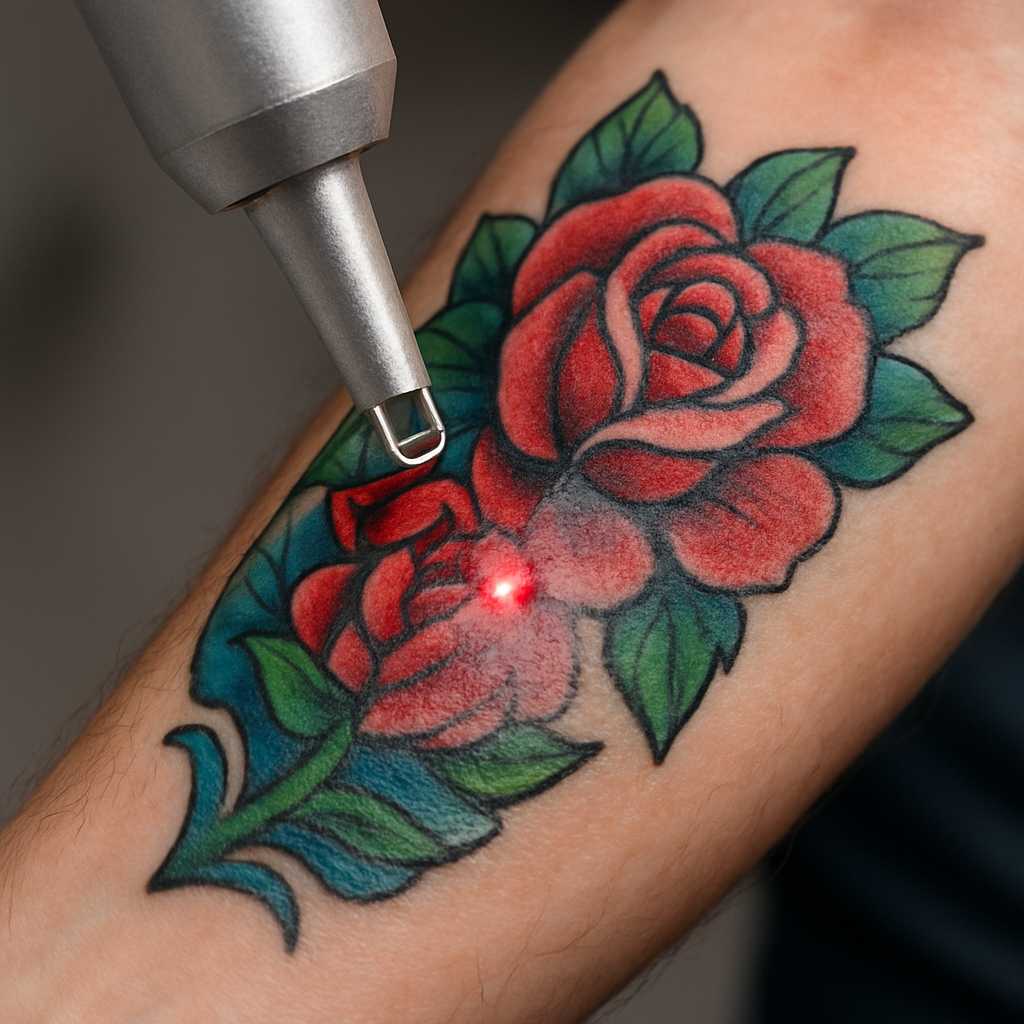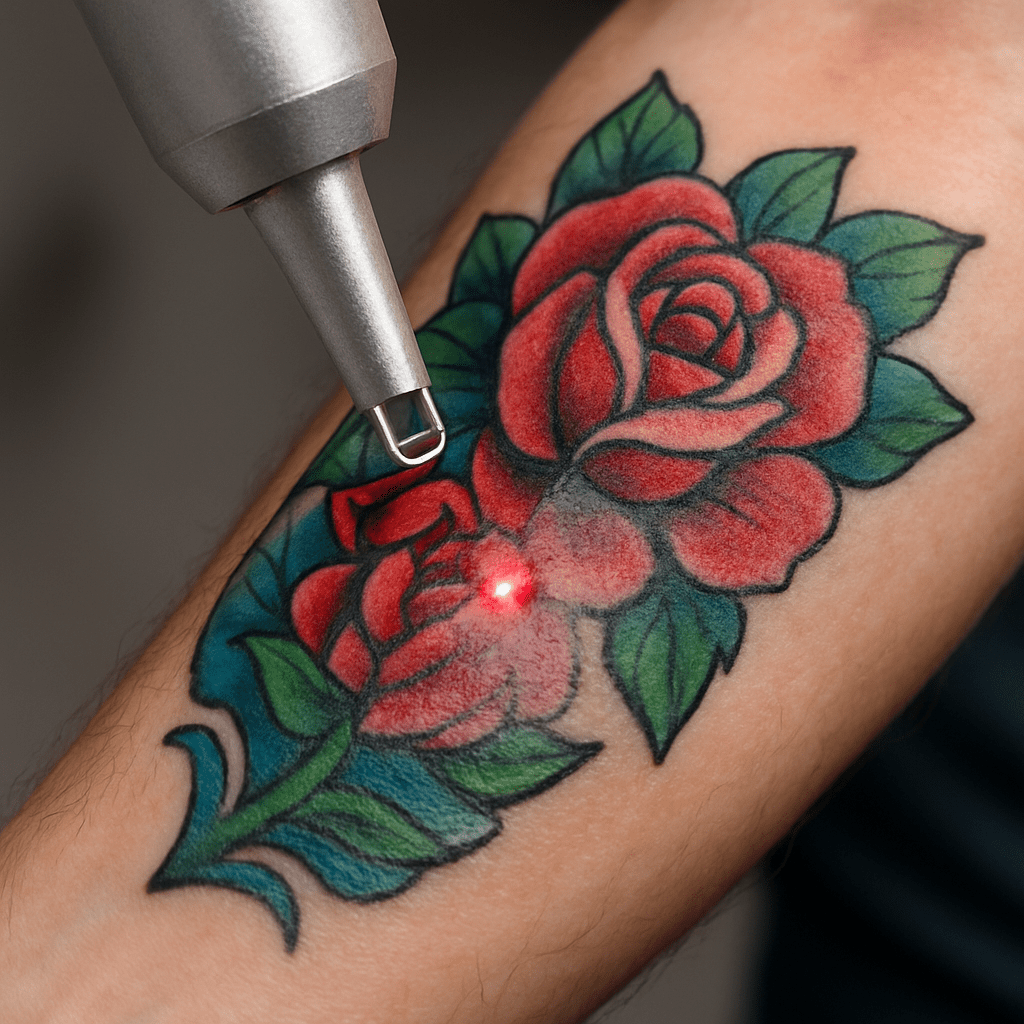Ever looked at an old tattoo and wondered, “What would I look like if it just… vanished?” You’re not alone. Tattoo removal before and after stories flood forums because, honestly, deciding to erase a piece of your past ink is a big step.
Maybe the design no longer fits your vibe, or it’s a faded reminder of something you’d rather forget. Whatever your reason, the idea of seeing the transformation—from that stubborn patch of ink to smooth, clear skin—feels almost like hitting a reset button on how you present yourself to the world.
But here’s the deal: tattoo removal isn’t magic. It takes time, patience, and the right approach. Some treatments can surprise you with how well they lighten the ink, while others leave subtle remnants or need several sessions. You’ve probably come across those jaw-dropping tattoo removal before and after photos online—yet, what most don’t show is the journey behind them.
So, how do you even get started? What should you expect from the process? And more importantly, can you really trust that your skin will bounce back looking natural? We get it—there’s a lot buzzing around this topic, and it’s confusing.
That’s why it’s key to find a clinic that doesn’t just sell you the promise but walks you through every stage with care and honesty. At Simcoe Cosmetic Clinic, for example, every treatment is personalized, taking into account your skin type, tattoo colors, and overall goals. Curious about what real results look like from someone local? We’ve put together insights that go beyond just images—you’ll learn about what happens during sessions, recovery tips, and how to maintain your skin’s health afterward.
Choosing tattoo removal might feel daunting right now, but remember: it’s your story, your skin, and your choice. And hey, before you dive in, it might be worth checking out some detailed guides on related treatments like laser hair removal or skin rejuvenation at Simcoe Cosmetic Clinic to see how their expertise shines across different procedures.
Let’s dive in and uncover what tattoo removal before and after really means—and whether it’s the right chapter for you to start next.
TL;DR
Thinking about tattoo removal? It’s not magic, but with the right clinic, you can see real changes that feel natural—like your skin telling a fresh story.
Tattoo removal before and after photos show progress, but what really matters is how your skin heals and regains its glow over time.
1. Understanding Different Tattoo Removal Methods and Their Results
So, you’re thinking about removing that tattoo. Maybe it’s a quiet regret or a bold statement that no longer fits who you are. Whatever the reason, understanding the different tattoo removal methods out there can save you time, stress, and a bit of your hard-earned cash.
Let’s break down the main options and what kind of results you can realistically expect—because, honestly, there’s no one-size-fits-all here.
1. Laser Tattoo Removal: The Modern Classic
This is the gold standard these days, hands down. Laser removal works by blasting your skin with concentrated light pulses that break down the ink particles.
The cool thing? New tech like the picosecond lasers, especially the PicoSure, can handle a wider range of ink colors with fewer sessions and less discomfort. This tech shatters ink particles in trillionths of a second—faster and more precisely than older lasers.
But here’s the catch: the effectiveness depends on ink color, tattoo age, and how deep the ink went in. Blacks and darker shades usually vanish quicker. Bright colors like blues and greens? They can be stubborn. Also, multiple sessions are almost always needed. Think months, not weeks.
And yes, there’s some discomfort, but most clinics (like Simcoe Cosmetic Clinic) use cooling devices or numbing creams to ease that sting. Healing time varies, but you might see some redness or slight swelling post-treatment.
2. Surgical Excision: The Quick But Invasive Fix
Ever wonder if they just cut the tattoo out? Well, that’s surgical excision — literally removing the tattooed skin and stitching the area back up.
This method works best for small tattoos but leaves a scar, so it’s a trade-off. If you want the tattoo gone in one go and don’t mind a surgical scar, it’s an option. But for large or colorful tattoos, it’s usually not recommended.
3. Dermabrasion: Scrubbing the Surface
This one’s a bit old-school. Dermabrasion involves sanding down the skin’s top layers to fade the tattoo.
It can work but risks uneven skin texture and scarring. Plus, it’s painful and doesn’t guarantee complete removal. Most professionals won’t recommend dermabrasion anymore because lasers offer safer, cleaner results.
4. Tattoo Removal Creams: Buyer Beware
You’ve probably seen those creams promising to erase tattoos without lasers or surgery. Let me stop you right there: these creams often don’t work as hoped.
They might fade the tattoo a little or lighten the skin temporarily, but they don’t break down ink deeply enough. Plus, some contain harsh chemicals that can irritate or damage your skin. If you want to know more about their effectiveness, check out this detailed review on effective tattoo removal creams.
What About Results? What Can You Really Expect?
When we look at tattoo removal before and after images, it’s tempting to expect flawless skin after a few sessions. But the reality is a bit messier.
Your skin’s natural healing plays a huge role. Some people see near-complete removal with little scarring, while others may have lingering shadows or slight discoloration.
Factors like skin type, ink depth, colors, and aftercare all affect outcomes. Darker skin tones, for example, need extra care to avoid pigmentation changes, but with advanced lasers that’s becoming less of an issue. That’s why choosing a clinic with the latest tech and experienced staff matters.
Here’s a real talk moment: it’s a gradual process. Expect multiple treatments spaced over weeks or months. The ink fades layer by layer, and your skin rebuilds bit by bit.
Is Laser Tattoo Removal Safe?
Absolutely, when done right. The best laser tattoo removal clinics use devices that target ink, not surrounding skin. Cooling systems also protect your skin during treatment. Just follow your provider’s aftercare instructions: no sun exposure, gentle cleansing, and patience as your skin heals.
According to recent expert insights, choosing a clinic equipped with the latest laser technology is crucial for safer and more effective results.
So, what should you do next?
Book a consultation—preferably at a medspa like Simcoe Cosmetic Clinic that offers up-to-date laser treatments and personalized plans. Understand what your tattoo removal journey will look like, hear about expected results, and set realistic goals.

2. Laser Tattoo Removal Before and After: What You Should Know
Ever stared at your old tattoo and wondered, “Can I really get rid of this for good?” It’s a question I’ve heard countless times. And honestly, it’s a bit of a journey, not an instant fix.
Here’s the thing—tattoo removal before and after can look wildly different depending on a bunch of factors. Size, color, placement, your skin type… all that jazz plays a part. So, if you’re hoping for a magic wand, the truth is it takes patience and a few sessions.
1. It’s a Multi-Session Process, No Matter What
We want fast results. I get it. But laser tattoo removal is kind of like peeling an onion, layer by layer. Every treatment breaks down the ink pigments little by little, allowing your immune system to flush them out naturally.
Think about it this way: the ink isn’t just sitting on your skin’s surface, it’s embedded deep. And that depth matters big time. Most people need anywhere from 6 to 12 sessions or more. It’s not a one-and-done deal.
After each visit, you’ll start seeing the tattoo get lighter, but it might not look perfect right away. And that’s okay! Some colors, especially blues and blacks, tend to fade better, while reds and lighter colors can be stubborn according to Removery’s extensive treatment data.
2. What Happens During and After Treatment?
If you’re imagining a lazer-beam sci-fi zap, you’re partly right. The laser pulses targeted light at the ink particles which shatters them, but that can sting—people often compare it to a rubber band snapping on the skin.
Afterwards? Expect some redness, swelling, maybe even blisters. It sounds scary, but it’s part of the healing dance. Your provider will give you instructions to keep the treated skin calm—usually some gentle cleansing, covering the area, and definitely no sun exposure. These steps help prevent scarring and protect your skin’s natural color.
And if you’re like me and worry about pain, many clinics offer cooling devices and even numbing agents to make this easier to handle.
3. Realistic Expectations Matter
Does laser tattoo removal erase your tattoo completely every time? Not always. Some inks lie too deep or are made from colors that resist laser light altogether. Lightening is the best-case scenario some days.
Talking openly with your provider is crucial to set those expectations. They’ll evaluate your tattoo’s size, colors, and ink depth, tailoring a plan that’s realistic for you. It’s also your chance to ask about potential side effects like temporary skin discoloration or minor scarring.
Honestly, anyone considering removal should understand that the “before and after” photos we see online often show the best case. Your journey might differ, and that’s perfectly normal.
4. Avoid DIY or At-Home Options
Look, it might be tempting to try creams or scrubs that claim to erase tattoos overnight. But many experts warn against at-home methods like creams or salabrasion—they can cause infections, scarring, and often just don’t work well. Cleveland Clinic advises seeing a trained professional for safe, effective removal.
Your skin deserves care, not shortcuts. So please don’t risk it.
5. Seeing Is Believing: Check Out Real Before and After Results
Want proof? You’re not alone. It’s reassuring to see genuine before and after photos from people who’ve been through the process. These images show the real fading, the healing stages, and give you a timeline to relate to.
Here’s a short video that breaks down laser tattoo removal before and after in real life. It walks you through what to expect—the fading, the skin’s response, even the potential discomfort. Take a minute to watch it; you might find it clears up a lot of doubts.
So, what should you do next?
Book a consultation with a trusted clinic. At a place like Simcoe Cosmetic Clinic, professionals will assess your tattoo and skin type, then create a personalized removal plan suited just for you.
Don’t let uncertainty hold you back; good guidance makes all the difference.
For a deeper dive into how laser removal reacts differently to every tattoo color and skin tone, check out studies shared by experts practicing safe, effective removal treatments at the Cleveland Clinic.
3. Non-Laser Alternatives and Their Effectiveness: Before and After Insights
So, you’re thinking about tattoo removal and wondering if non-laser options can really cut it? That’s a fair question because not everyone is up for the laser buzz and the multiple sessions it demands.
Let’s be real: you want to see that tattoo removal before and after transformation without landing yourself in a mess of chemical burns or scars. Here’s the lowdown on some common non-laser alternatives and how they actually perform in the real world.
Tattoo Removal Creams: Too Good to Be True?
You’ve probably seen those tattoo removal creams promising to fade or wipe out ink like magic. Spoiler alert: they don’t work the way you think.
Here’s why. Tattoo pigment isn’t just sitting on your skin’s surface; it’s embedded deep in the dermis, the skin layer below the outer layer. These creams usually only bleach or slough off the top skin layers, which means the actual ink stays put. Sure, you might notice a slight fade or discoloration, but it’s often uneven and can leave your skin looking blotchy or weirdly tinted.
Worse, many of these creams contain harsh chemicals like trichloroacetic acid or bleaching agents not approved by the FDA. People have reported serious side effects including burning, scarring, and allergic reactions. Honestly, it’s a gamble that rarely pays off. Read more on why these creams fall short and carry risk at Removery’s detailed discussion on tattoo removal creams and dangers.
Dermabrasion and Salabrasion: Scraping and Sanding Your Skin?
Now, dermabrasion sounds fancy—it’s a medical procedure where a rotating brush sands down the skin to erase that tattoo ink. But here’s the catch: it’s painful, can leave you with a scarred patch, and still might not get all the ink out because it risks only hitting the surface, not getting deep enough.
Think about it this way: it’s like sanding a wooden table to get rid of some paint but stopping before hitting the wood because you’re afraid to go too deep. You’ll get some fading, but the paint (or ink) remains, and the surface might be rough or scarred.
And salabrasion? It’s basically rubbing salt into your skin until it bleeds, then letting it scab over and heal. This one’s typically a DIY nightmare. It’s painful, slow, and almost always leaves scar tissue that can make the area look tough and leathery. People hoping for smooth, clear skin often end up far from that dream.
If you want a peek at real stories and pics from folks who tried these, the results are mixed at best and often disappointing.
Surgical Excision: The Cut-It-Out Option
Here’s a method that’s quick, but kinda drastic. Surgical excision involves a doctor cutting out the tattooed skin and stitching the area back together. It’s effective at removing the tattoo completely in just one session, but it leaves a scar. Not ideal for large tattoos or highly visible spots.
Cost-wise, it can be reasonable for small tattoos but get expensive if you need skin grafts or larger area work. The scar is a permanent trade-off, and for many, it’s not worth trading one mark for another.
You can learn more about the pros and cons of this approach from detailed resources like Tatt2Away’s overview of tattoo removal methods.
Non-Laser Innovations: Is There a Middle Ground?
Curious about some newer non-laser methods? Some clinics now offer treatments that use your body’s natural healing along with topical products or other techniques to fade tattoos more safely than creams or sandpaper.
While these are promising, they’re often slower and not as predictable as laser removal, but they might work better for some skin types or tattoo colors. The key is a consultation with a pro who can guide you through options tailored to your tattoo’s size, colors, and location.
One thing stands out: if you’re after real tattoo removal before and after results that won’t leave lasting scars or skin damage, relying on creams or harsh sanding is a gamble. It’s tempting to try quick fixes, but the risks usually outweigh the rewards.
If you want to see how real people fare with these methods or understand laser alternatives, check out expert resources on the non-laser tattoo removal process and expected results at Removery and the comprehensive cost and method breakdown at Tatt2Away.
So, what’s the takeaway here? Non-laser alternatives often promise a lot but deliver little besides possible skin damage. Before you experiment, think about what really matters: safe, effective removal that leaves your skin intact.
And remember, consulting with professionals at places like Simcoe Cosmetic Clinic can help you understand the safest, most effective path tailored just for you. Because when it comes to tattoo removal before and after, you deserve results—and a smooth road getting there.
4. Caring for Your Skin: Tattoo Removal Aftercare Tips and Results
So, you’ve booked your laser tattoo removal session, and you’re probably wondering: what’s next? Because honestly, the laser itself is just the start. How you care for your skin right after treatment can make or break how your tattoo removal before and after pictures turn out.
Here’s the thing about laser removal — it’s like giving your skin a little battle wound. It’s going to need proper TLC if you want that clean, smooth look without any annoying scars or setbacks.
1. Keep It Clean and Protected
Right after your session, you’ll have a bit of redness, maybe some swelling or tiny blisters. It’s your body doing its thing to clear out the ink particles. But you can’t just go about your day like nothing happened.
For the first 3 days, keep the area covered with a sterile bandage and apply an antibiotic ointment recommended by your technician. No makeup, no lotions, not even your favorite skin serum — just clean, gentle care.
After that, you can switch to moisturizing with something like Aquaphor or a vitamin E ointment. These help soothe your skin and encourage healing, which speeds up how soon you get to see those tattoo removal before and after results that get you smiling.
2. Stay Out of the Sun
Sun exposure is your skin’s worst enemy during this healing phase. You don’t want sunburn or tanning on a wound that’s already sensitive. That can cause pigmentation issues or even delay your next appointment.
Always use a high SPF cream (25 or higher) when you’re outside, even on cloudy days. And if possible, cover the area with clothing or a loose bandage. It might feel like a drag, but trust me, it’s worth it.
3. Hands Off the Scabs and Blisters
Got scabs or blisters? Resist the urge to pick, pop, or scratch. This is so tempting — who hasn’t wanted to peek at a scab or peel it off to see what’s underneath?
But picking only invites infection and can cause scarring. Let those scabs fall off naturally, and if you see blisters forming, let them drain without bursting them yourself. This patience pays off in better healing and smoother skin.
4. Take Care Inside and Out
Did you know your immune system plays a starring role in removing your tattoo ink? Think of it as your internal cleanup crew. Stay hydrated, eat nutritious foods rich in antioxidants, and maybe even lean on vitamin supplements if your doctor agrees.
Keeping your body strong helps speed up the natural breaking down of the ink bits. So, the healthier you are, the quicker, cleaner your tattoo removal before and after journey goes.
5. Know the Healing Timeline
Healing isn’t instant. It usually takes 4 to 8 weeks for your skin to fully recover between sessions. Some people heal faster, some slower — it depends on your skin type, tattoo depth, and how well you follow your aftercare.
Trying to rush the process by squeezing treatments too close together? Not a great idea. You might irritate your skin and risk scarring, which nobody wants.
If you want to dive deeper into detailed aftercare steps, check out this thorough guide on laser tattoo removal aftercare by LaserAll Clinic. They really cover all those day-to-day do’s and don’ts.
6. Listen to Your Skin and Your Technician
Every session, have a quick chat with your technician about how your skin is feeling and what you should do next. They’ll give you personalized tips based on how your skin reacts—which is super valuable because no two skins are exactly alike.
Remember, your post-treatment care is just as crucial as the laser itself to get the results you want.
Want expert insights into managing your skin’s journey beyond tattoo removal, including how to keep your skin fresh and wrinkle-free? You might find this article about facial treatments in Barrie a good next step for glowing skin after your tattoo is gone.
You’re reclaiming your skin and your confidence. That’s powerful.
Oh, and a quick heads up — if you’re curious about the connection between your tattoo removal journey and potential scarring, Metropolis Dermatology has a comprehensive breakdown about understanding and minimizing scarring after tattoo removal. It’s smart to know your risks and how to dodge them.
Lastly, sometimes stepping into unexpected areas is good. For example, knowing about unrelated but interesting things like fire safe ball valves and their safety features can remind us how important protecting heat and pressure points can be — kinda like protecting your skin post-laser!
Yes, tattoo removal aftercare might look like a lot at first. But take it one day at a time and be gentle with yourself and your skin. Before you know it, you’ll love your tattoo removal before and after transformation that much more.

5. Comparing Costs and Effectiveness: A Side-by-Side Overview
Okay, so you’ve finally decided to take the plunge and erase that old tattoo. But now comes the headache: which method gives you the best bang for your buck without sacrificing results? You’re not alone in feeling overwhelmed here. Comparing tattoo removal options feels like sorting through a maze, right?
Let’s cut through the noise. Most people want to know two big things: what’s it going to cost, and how well does it actually work? That’s the real heart of the matter—because you want to see those “tattoo removal before and after” images and believe you’ll get there without breaking the bank or ending up with a mess on your skin.
Laser Tattoo Removal: The Gold Standard
When you hear about safe, effective tattoo removal, it almost always involves laser technology. Specifically, Picosure (picosecond) lasers and Q-Switch (nanosecond) lasers are the big players. Both work by breaking up the ink particles in your skin so your body can flush them out. But here’s the kicker: the difference isn’t as dramatic as fancy ads might have you believe.
Confused? Think about it this way—imagine two super-fast cameras taking snapshots of a moving object. One might be faster by a tiny fraction, but the overall picture quality is pretty similar. Picosure lasers deliver faster pulses and may clear ink slightly quicker, but they cost way more—often 3 to 4 times the price per session. Meanwhile, Q-Switch lasers hold their own pretty well, delivering solid results without the sticker shock.
So what about the number of sessions? Some studies suggest Picosure might shave off a session or two compared to Q-Switch lasers. But honestly, the difference tends to be 6 treatments versus 7 or 8. When you pile on the cost per session, that adds up fast. If you’re on a budget, a high-quality Q-Switch laser might actually be your best friend.
Non-Laser Methods: Why They Usually Don’t Pay Off
Have you seen those tattoo removal creams or dermabrasion options at the drugstore or online? They sound tempting—cheap, easy, no needles—but here’s what’s really going on: they rarely scratch beneath the surface of your skin to get rid of ink. At best, creams fade a tattoo a little on the surface, but the tough ink buried deep stays put.
And methods like dermabrasion or salabrasion can be downright brutal on your skin. They often cause pain, scarring, or pigmentation changes. Plus, surgical excision—which literally cuts out the tattoo—can leave scars and only works for small tattoos. So, if you want smooth skin, these options aren’t your best bet.
Truly effective tattoo removal means investing in professional laser treatments. Not only are they far safer, but they also offer real, lasting results—meaning better “tattoo removal before and after” pics without the horror stories.
Let’s Break It Down: Quick Comparison Table
| Feature | Picosure (Picosecond) Laser | Q-Switch (Nanosecond) Laser | Non-Laser Methods (Creams, Dermabrasion, Excision) |
|---|---|---|---|
| Effectiveness | High; slightly faster ink breakdown for many colors | High; very effective with quality devices | Low to moderate; often superficial or risk scarring |
| Average Number of Treatments | 6-8 sessions | 7-9 sessions | Varies; often incomplete results |
| Cost Per Session | High (3-4x Q-Switch) | Moderate | Low initial cost but potential for added medical costs |
| Side Effects | Minimal with proper care | Minimal with proper care | Possible scarring, burns, infections |
Okay, so if you’re sitting there wondering: “Is it worth paying more for a Picosure laser?” The honest answer is, maybe, but probably not by a huge margin. Your skin health, immune system, and tattoo specifics (like colors and placement) often play a bigger role in results than just the laser tech. Experts break down these nuances here, and it’s worth giving it a read before committing.
And what about those quick fixes? Don’t fall for creams or home remedies. You can cause more harm than good, and end up with scars or infections needing professional treatment later. If saving your skin and peace of mind matters, laser removal by pros at places like Simcoe Cosmetic Clinic is the way to go.
So, what should you do next? Do your homework, focus on real results over hype, and pick a trusted clinic that uses well-maintained equipment with certified laser technicians. Your future skin will thank you.
If you want to explore all your laser removal options and costs in detail, here’s a great resource guiding you through the pros and cons of various methods. And to understand how the laser’s light wavelength affects your tattoo colors, check out this detailed explanation on laser technology.
Conclusion
So, here we are at the finish line—looking back at the whole tattoo removal journey. If you’ve ever stared at a fading tattoo and wondered, “Is this really gonna work for me?” you’re not alone. The truth is, results vary, and that’s okay. Skin type, immune response, and even tattoo colors play a huge role on how your “before and after” will look.
But don’t let uncertainty hold you back. Choosing a trusted clinic like Simcoe Cosmetic Clinic, with experienced techs and well-maintained lasers, can make a world of difference. You’re not just fading ink; you’re reclaiming your skin and confidence.
And hey, skipping shortcuts like creams or at-home gadgets? Absolutely the right call. Those often cause more headaches (and scars) than fixes. Real removal takes time and patience, but the payoff is worth it.
Thinking about your next step? Start small: book a consultation to see what your tattoo removal before and after could realistically look like for you. Ask questions, understand the technology, and feel good about the path you’re choosing. Because at the end of the day, it’s about feeling like yourself again—only better.
FAQ
Thinking about tattoo removal before and after results can spark all kinds of questions, right? I get it. It’s a big step, and you want to know exactly what to expect before diving in. Let’s tackle some of the most common questions folks bring up when they’re considering this journey.
How many sessions will I need to see real tattoo removal before and after changes?
Honestly, it varies quite a bit. Most people see noticeable fading after 3 to 7 sessions, but it depends on your tattoo’s size, age, ink colors, and your skin’s healing response. Think of it like peeling away layers—each session chips away a bit more.
And if you’re dealing with super bright or layered ink, it might take more time. The key is patience, combined with treatment from pros who know their lasers inside out.
Can I trust the tattoo removal before and after photos I find online?
Good question. Some photos out there are heavily edited or don’t tell the full story. Here’s a tip: look for galleries from clinics that show pictures at consistent lighting and angles. And if possible, ask to see real client results during a consultation to set your expectations right.
Is tattoo removal painful? How does it feel?
Not gonna lie, it’s not a walk in the park, but it’s manageable. Most folks describe the sensation as a rubber band snapping against the skin, sometimes with a warm or tingling afterfeel. Everyone’s pain tolerance is different, though.
Clinics like Simcoe Cosmetic Clinic often offer numbing options or cooling devices to make it easier. Remember, the pain is brief and generally tolerable, especially knowing it’s toward a fresh start for your skin.
Will tattoo removal before and after results leave scars or skin damage?
The short answer: usually no, if done by skilled professionals. Lasers target the ink, not your skin, but improper treatment or overdoing it can cause issues.
That’s why avoiding quick-fix creams or DIY machines is a smart move—they often backfire. A trusted clinic with experienced technicians minimizes risks and helps your skin heal beautifully, revealing cleaner-before-you-ever-thought-possible skin.
Can I remove any tattoo color equally well?
Colors react differently to laser wavelengths. Black and dark inks are the easiest to break down, so you usually see faster, clearer before and after results with those.
Bright colors like green, blue, or yellow can be stubborn and may require specialized lasers or more sessions. So if your tattoo is bursting with color, just know it might take a bit longer to fade them out.
What should I do to prepare for my tattoo removal sessions?
Simple stuff, really. Avoid sun exposure a couple weeks before treatment and don’t pick or scratch the tattoo area.
Oh, and skip tanning or chemical peels nearby because they can mess with laser effectiveness or healing. Hydrated skin also responds better, so drink water and keep your skin moisturized.
How do I know if tattoo removal is right for me?
That’s a personal call, but if your tattoo feels like a shadow hanging over you, or you just want clean skin again, it’s worth chatting with a pro.
Start with a consultation at a place like Simcoe Cosmetic Clinic where they walk you through realistic before and after expectations based on your unique tattoo. That way, you get a feel for the journey ahead, no surprises.
So, feeling ready? Remember, tattoo removal is a marathon, not a sprint. But with the right info and the right people, you’ll be looking at those tattoo removal before and after photos and thinking, “Hey, that could be me.”




